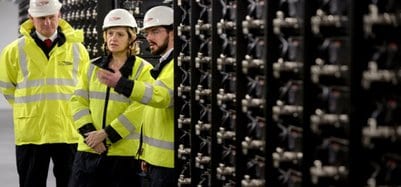
The largest battery storage project in Europe has been officially unveiled today in the U.K. town of Leighton Buzzard, Bedfordshire, near London.
The fully automated Smarter Network Storage (SNS) project is a 6MW/10MWh battery substation that has been officially unveiled by the U.K. government’s Parliamentary Under Secretary of State for Climate Change, Amber Rudd.
The SNS is the result of a collaboration between Berlin-based software architects Younicos, Samsung SDI, U.K. Power Networks (UKPN) and utility S&C Electric Europe, which acted as lead supplier on the £18.7 million ($29.3 million) project having accrued extensive energy storage experience on a number of other U.K. and global projects.
The project is a two-year energy storage trial that the collaborators hope will pave the way for greater integration of renewable energies into the U.K. grid and save as much as £6 million ($9.4 million) on traditional network reinforcement methods.
Speaking at the official switch-on of the system, Rudd remarked: “Cutting-edge smart networks like this will both enhance U.K. skills and allow us to capture and store new forms of energy generation.
“This [project] will help us to build a smart grid, which reduces the need for further costly investment in grid reinforcement by enabling greater integration of cleaner renewable energy sources into our existing energy network.”
A large bulk of funding for the SNS was provided by the Low Carbon Networks Fund, with further funding by the UK Power Networks a consortium of additional project partners, including Imperial College London, Newcastle University, the National Grid, Pöyry Management Consulting, SmartestEnergy, Swanbarton Limited, KiWi Power and AMT-SYBEX.
Easing integration
Younicos contributed custom-built intelligent software architecture and components for the project, designed to regulate power frequency and load-shifting and to stabilize the grid more effectively than traditional technologies. The net result of the two-year trial, it is hoped, is more space on the grid for intermittent renewable energies, integrated at much lower costs than previously.
“Energy storage can play a major role in balancing the grid as it solves the problem of renewable intermittency by absorbing surplus power and releasing it when needed,” said S&C Electric Europe MD Andrew Jones. “This function simultaneously helps to securely balance capacity and supply and protects the grid from stress events. The introduction of energy storage substations like this can decrease the need and cost of traditional reinforcement, such as transformers and cabling.”
The technology will absorb excess electricity fed into the system and release it to meet demand. Younicos says that the SNS will bring a balance between intermittent and inflexible low carbon technologies on the grid, and more traditional fossil fuel-basd energy, and will explore the capabilities and value in alternative revenue streams for storage technologies.
“This ground-breaking project forcefully demonstrates the many revenue streams and savings that energy storage can enable today,” said Younicos’s CTO Clemens Triebel. “Together with UKPN, S&C and other partners, we are showing grid operators, utilities and other stakeholders both in the U.K. and around the world an effective way to cost-efficiently reinforce and improve grid infrastructure, while facilitating increased deployment of clean energy from wind and solar.”
The two-year trial will test a wide range of difference services that storage can bring to the grid, said Ben Wilson, UKPN’s CFO and director of strategy and regulation. “The project will allow us to explore and improve the economics of electrical energy storage, and assess the potential benefits to the electricity system in a number of sustainable and flexible ways,” he added.
Source: PV Magazine. Reproduced with permission.











